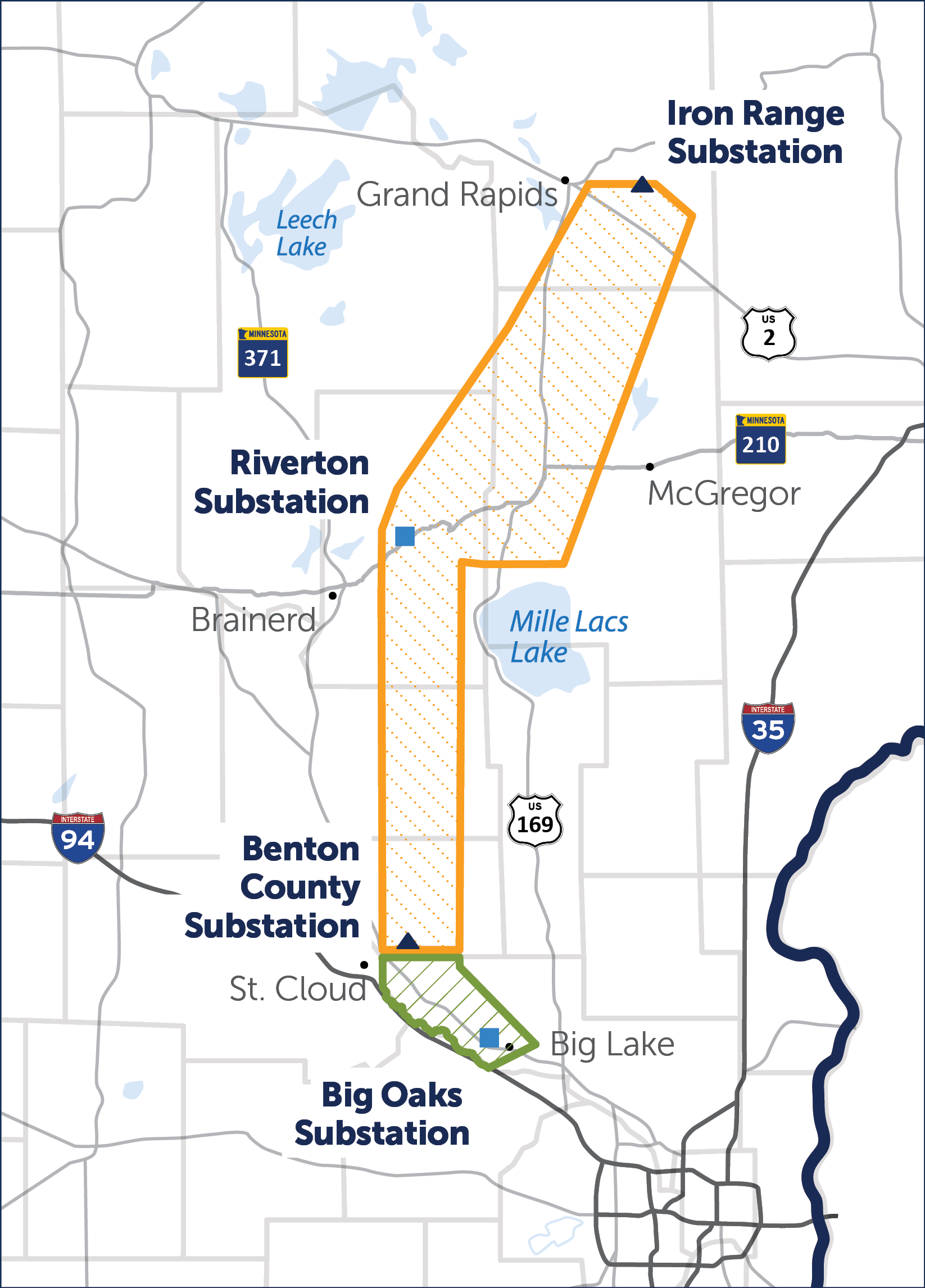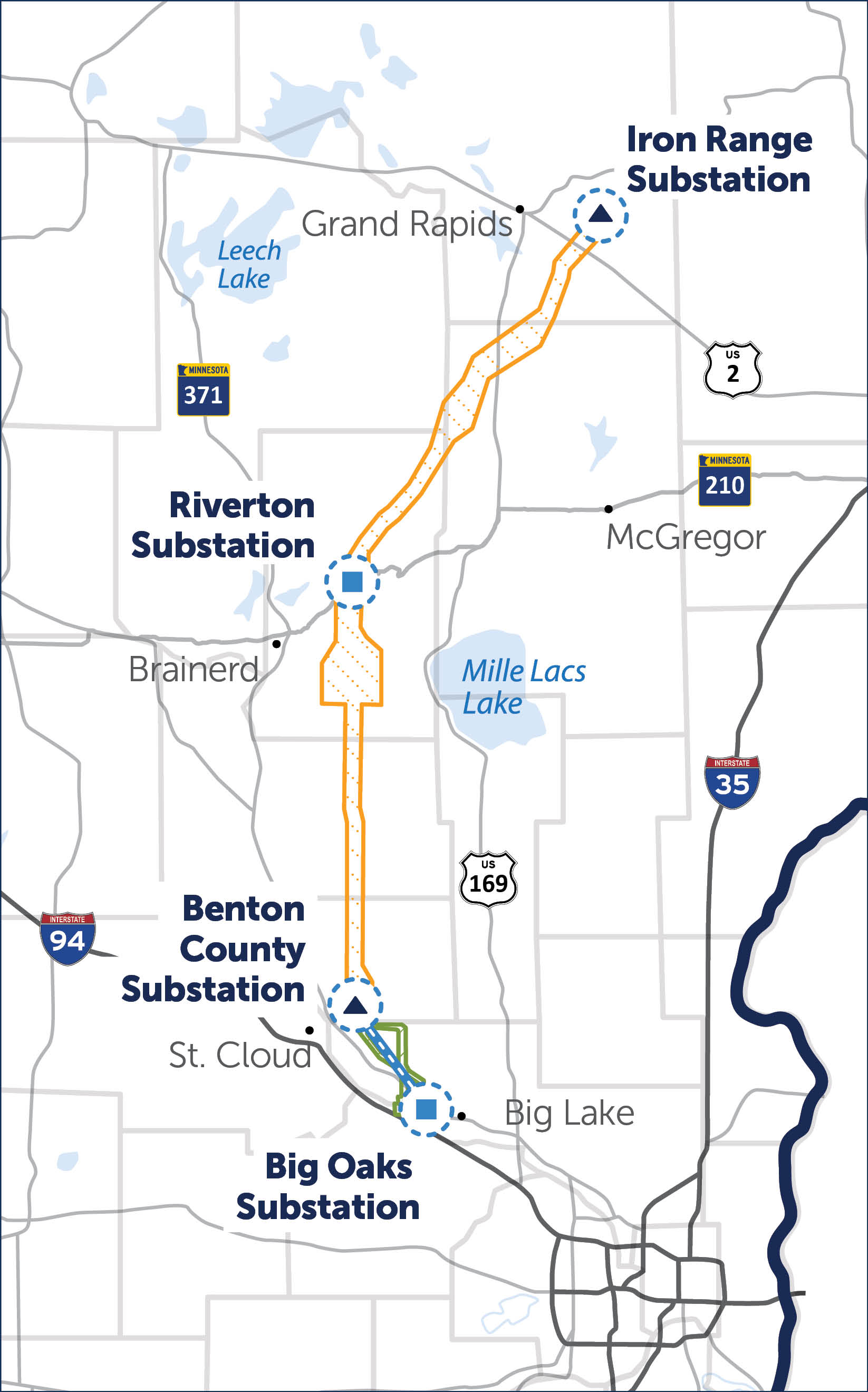Documents & FAQs
Project documents
Fact Sheets
Outreach materials
Fall 2022 workshop materials (study area)
Frequently asked questions
The Northland Reliability Project will ensure the power grid in northern and central Minnesota continues to operate safely and reliably as energy resources in Minnesota and the regional power system continue to evolve. As generation resources shift from fossil fuels to more renewable energy like wind and solar, the Northland Reliability Project is one part of the solution to:
- Provide system support as the use of fossil-fueled baseload generators continues to evolve.
- Facilitate increased capacity to safely and reliably deliver clean energy from where it is produced to where it is needed by our customers and members.
- Enhance system resiliency during extreme weather events.
- Plan proactively to meet changing customers’ and members’ power needs due to decarbonization and electrification.
The Northland Reliability Project will allow Minnesota Power and Great River Energy to continue delivering reliable, cleaner energy to our customers and members. This project will enhance the stability of our regional electric system and support a reliable, resilient and flexible energy grid so any type of generation, and from more locations, could be connected to meet the long-term energy needs of our customers and members. The Northland Reliability Project is part of a large portfolio of regional transmission projects approved by MISO, the region’s grid operator, in the summer of 2022. All of the projects in that portfolio work together to provide broad regional benefits in addition to local reliability benefits. While the Northland Reliability Project will directly support reliability in northern and central Minnesota, it supports reliability well beyond Minnesota, as well.
Electricity is generated at power plants, wind or solar facilities and other generation sites before it is delivered across a complex, interconnected system of power lines and substations to electric customers and cooperative members. Think of transmission lines as the interstates, or the super highways of the electric system. Transmission lines carry large amounts of high-voltage electricity from generation sites to substations, where it is “stepped down” to lower voltages so it can be delivered across the electric distribution system, and can be safely used at homes, farms and businesses.
The study area is the geographic area in consideration for the route of the power line. We developed the study area based on where the new transmission line will need to connect into existing infrastructure. We’ll narrow down potential routes based on the state of Minnesota’s requirements, as well as public input, engineering, permitting and construction feasibility. We will look for opportunities to follow existing utility corridors and use land already being used for power lines whenever it makes sense.

The Northland Reliability Project is one of 18 regional transmission projects approved by MISO, the region’s grid operator, in the summer of 2022. Because the entire region benefits from the Northland Reliability Project, the cost is spread across all of the utilities who are members of MISO in the region. The Northland Reliability Project’s estimated overall cost is approximately $970 million and ultimately, everyone who uses electricity in the MISO region will pay a share through their electric bills as costs flow through to electric utility customers and electric cooperative members. While there is cost associated with new transmission, transmission makes up a small portion of electric bills and the value of this project is high. The project is one of many that will ensure reliability in our region as our generation resources evolve. MISO estimates the benefit of bringing on more low-cost renewable energy, along with other benefits, outweighs the cost of these projects by two to four times.
This project is in the early planning stages and includes a robust stakeholder engagement process. We’ll apply for a Certificate of Need and Route Permit from the Minnesota Public Utilities Commission and work with local jurisdictions, landowners, customers, members and agencies while following permitting requirements throughout project development and construction. The proposed schedule is as follows:
- 2022 – Project planning and initial stakeholder engagement
- 2023 – Routing, public engagement and permitting
- 2024-2026 – Permitting, engineering, environmental surveys, real estate and public engagement
- 2027-2030 – Construction
- 2030 –Anticipated in-service *
- *The schedule is subject to change.
Yes and yes! We need your input during the routing process. You can get information and provide input by visiting us at workshops and public meetings, browsing this website and more. Property owners within the route corridor will receive information throughout project development and we are always available to discuss the project with each individual property owner. Finally, you can stay up to date on project happenings by visiting this website regularly and signing up for future email updates.
We start by identifying a study area and through the routing process, ultimately narrow down to a specific route. Our routing process includes robust community engagement. You’re the experts in your communities and we need you to share your insights so we can have a more complete picture of opportunities and constraints in your area. We analyze and study cost, environmental impacts, engineering, constructability and more. After we receive your input and analyze everything we have heard and studied, we will select a proposed route to submit in our Route Permit to the Minnesota Public Utilities Commission. For this project, we will be submitting an application for a combined Certificate of Need and Route Permit.
If you have property in the route corridor, you will receive communications about the project by mail and you will be invited to public open house meetings. If you own property on the final route that is approved by the Minnesota Public Utilities Commission, a project team member will contact you and begin the process for obtaining an easement on your property for the project’s right-of-way needs. A right-of-way is a strip of land used for a specific purpose such as the construction, operation and maintenance of a road or transmission line and it is typically secured in the form of an easement. The easement is the document allowing Minnesota Power and Great River Energy the right to use the portion of your property for the transmission line project’s needs. More information on the easement process will be made available when we have a better idea of what our proposed route will be.
The route corridor is a narrowed area being considered for the power line. We developed the route corridor based on where the new power line will need to connect into substations, input gathered during our fall 2022 stakeholder workshops and the opportunity to route near existing utility corridors and land already being used for power lines. The route corridor is narrower than the original study area, and wider than the 150-foot right of way that will be needed for the construction, operation and maintenance of the line. The next step in route development will be to define route alternatives within the route corridor.

We are proposing 120- to 180-foot-high single-pole steel structures with arms on both sides of each structure to carry the lines. For this type of structure, we’d anticipate having about five to eight for each mile of our line. Although this is our proposed typical design, this could change based on environmental needs, permitting requirements and engineering standards. We’ll continue to share more details as they become available and we complete more engineering activities.
If you have questions not answered here, you can fill out the comment form, email connect@northlandreliabilityproject.com or call 218-864-6059. Each comment goes to our project team and one of our team members will get back to you.
